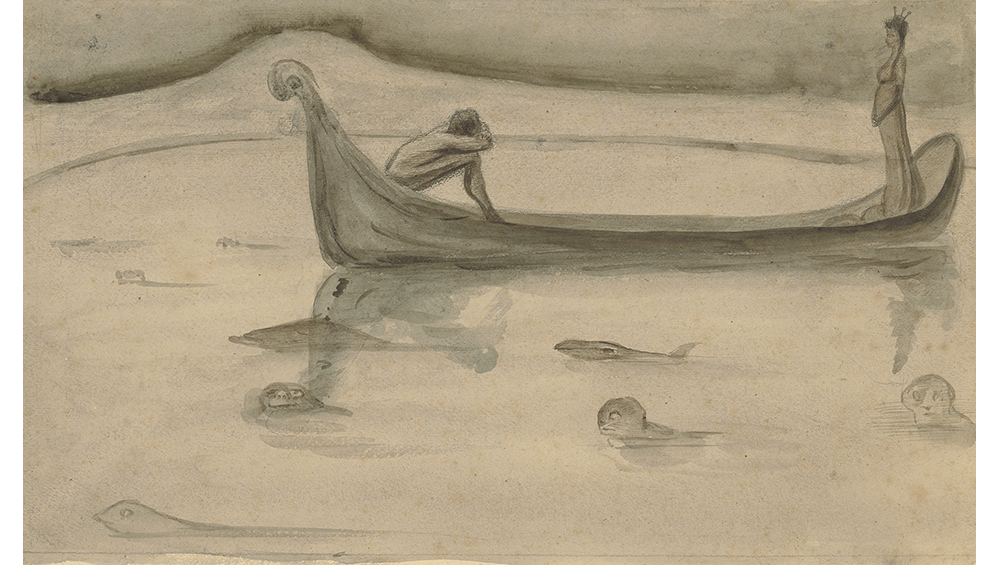
Alfred Kubin. Sadness, after, 1900. Ink on paper, 20.5 x 34.6 cm, The Albertina Museum, Vienna © Eberhard Spangenberg, München / Bildrecht, Vienna 2024.
Albertina Modern, Vienna, Austria
14 August 2024 – 12 January 2025
by CHRISTIANA SPENS
While Sigmund Freud was writing about the significance of “the uncanny”, and the repressed fears and memories that fuel such a mental state, a young Alfred Kubin (1877-1959) was well established as a supreme draughtsman of precisely the nightmarish scenes that Freud’s patients felt tormented by. From perversions to plagues, scenes of temptresses to gruesome births, Alfred’s inner life, illustrated prolifically during the early years of the 20th century, might have been a graphic guidebook to the neuroses that Freud was so concerned with.
At Albertina Modern, a new exhibition allows us to see first-hand the visions of Kubin on all that is evil, which was the dominant theme of his life and works. This compellingly nightmarish selection of etchings and drawings (chosen from the 1,800 that the Albertina Museum holds) reveals the Austrian artist’s deeply pessimistic mindset and gives some context for his pathological fascination with the dark side of the human psyche. In his precise, stylised works on paper, Kubin presents gruesome monsters, uncanny apparitions and threatening, overtly sexualised women, all encapsulating his greatest traumas and fears. We step into these ominous visions in which evil prances around, preying gleefully on helpless men, presenting life as a cruel prison with ominous executioners looming all around. These images are like snapshots to a personal hell, which is universally recognised: war games, prisoners, torture, executioners, refugees, persecuted figures, plagues and pandemics fill the many frames against walls of deep blood red. A great number of Kubin’s works revolve around the uncanny that Freud was so fascinated by – nightmares of demons, mystical hybrid beings, grotesques, femme fatales and bleak scenes of hell.
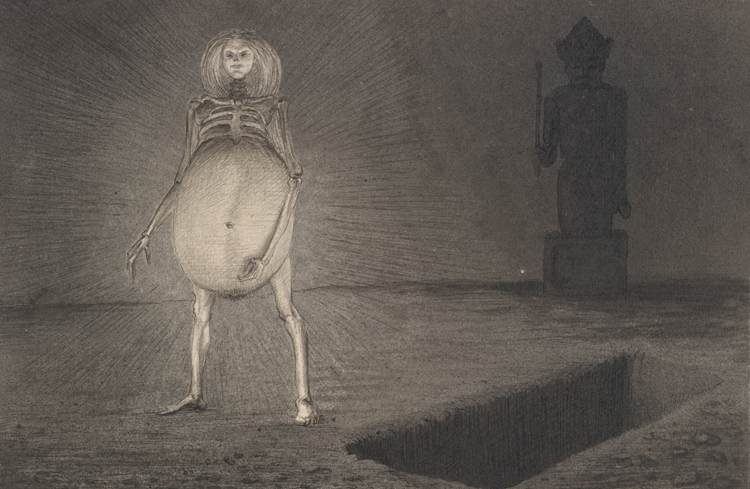
Alfred Kubin. The Egg, c1901/02. Ink on paper, 15.8 x 23.8 cm, The Albertina Museum, Vienna © Eberhard Spangenberg, München / Bildrecht, Vienna 2024.
That said, the drawings are beautiful and strangely humorous at times. Perhaps because they are stylised in such a way as to recall children’s fairytales, they do not seem overly terrifying for the most part, despite the subject matter. There is a sense of absurdity to the images and a tone of flagrant existential melodrama, that soften the pain at their core. The female figures, especially, are caricatures of the fear of the feminine; even if they emerged from the artist’s paranoia, affirmed by sexist assumptions of the time, Kubin had many reasons to feel tormented by the feminine archetype. These visions are where a tortured mind goes – to a hellscape of paranoia and perversion, which the artist used drawing to work through, perhaps cathartically. So, what did lead him to these visions; what troubles created these persistent terrors, this obsession with sex and death?
It is no surprise to learn that Kubin had a very difficult childhood. He was born in northern Bohemia, and his mother’s death from tuberculosis, when he was 10, weighed heavily. She was the first person he was to witness dying, and he depicted this scene in a drawing of his father holding her lifeless body. Sadly, more deaths were to follow. His stepmother, who was also his mother’s sister, died after childbirth a couple of years later, and at about this time he was abused by a pregnant woman. As he later recalled: “I was just 11-and a-half when I was involved in sexual games by an older woman, which upset me beyond measure and cast a shadow well into my manhood years.”1 With this personal context, the images of grotesque births, pregnant women and stereotypical temptresses do make some sense.
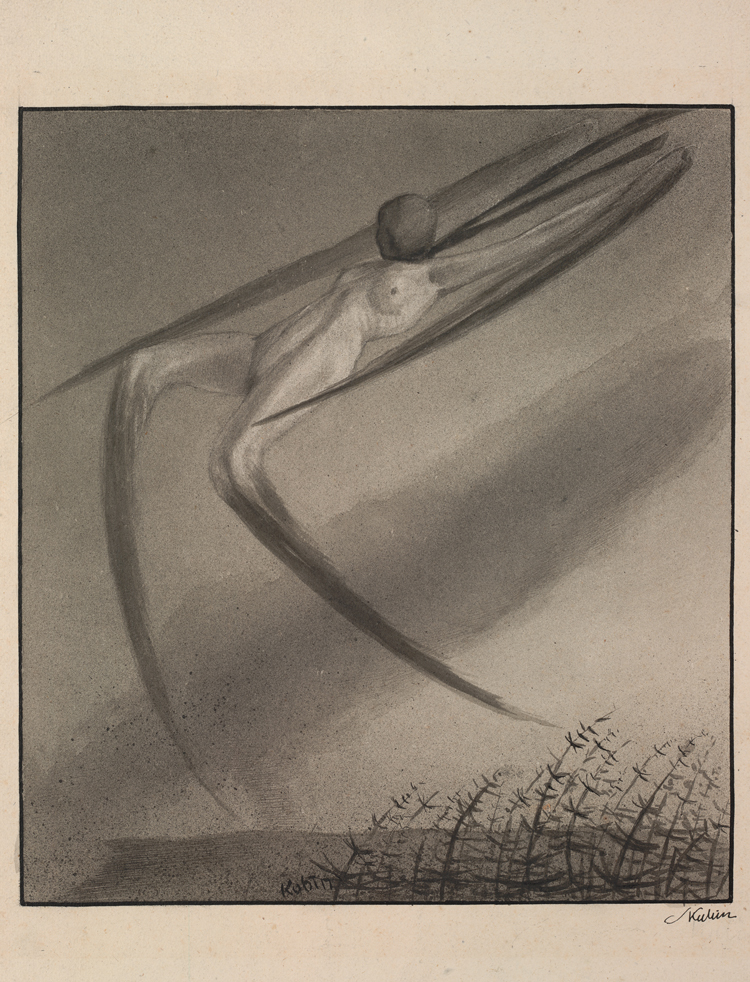
Alfred Kubin. A Dream Visits Us Every Night, ca 1902/03. Ink on paper, 26.3 x 23.5 cm, The Albertina Museum, Vienna © Eberhard Spangenberg, München / Bildrecht, Vienna 2024.
After failing to graduate from grammar school as a troubled teenager, he was apprenticed to his uncle by marriage, a landscape photographer in Carinthia. It was at this time that the young Kubin was introduced to nightlife, becoming obsessed with women and drinking excessively, which led to a further deterioration of his mental and physical health. He had severe depression and panic attacks, and in 1896, at 19, he attempted suicide at his mother’s grave. His rusty pistol failed to fire, however, and he did not try a second time, instead choosing to go home and give life another chance.
In an attempt to please his strict father, he embarked on a short stint in the Austrian army the following year, but this ended with a nervous breakdown after only 18 days, this time at his division commander’s funeral. Kubin was put in an army hospital for four months before returning home. Thereafter, his father allowed him to study with the painter Ludwig Schmitt-Reutte at a private academy for a year, before entering the Munich Academy of Art in 1899, a move that was to save him. In Munich, Kubin discovered the work of Edvard Munch, Odilon Redon and Max Klinger, later remembering a sudden vision of “a torrent of black-and-white images” on seeing Klinger’s work for the first time. He said later: “Here a new art was thrown open to me, which offered free play for the imaginative expression of every conceivable world of feeling. Before putting the engravings away, I swore that I would dedicate my life to the creation of similar works.”2
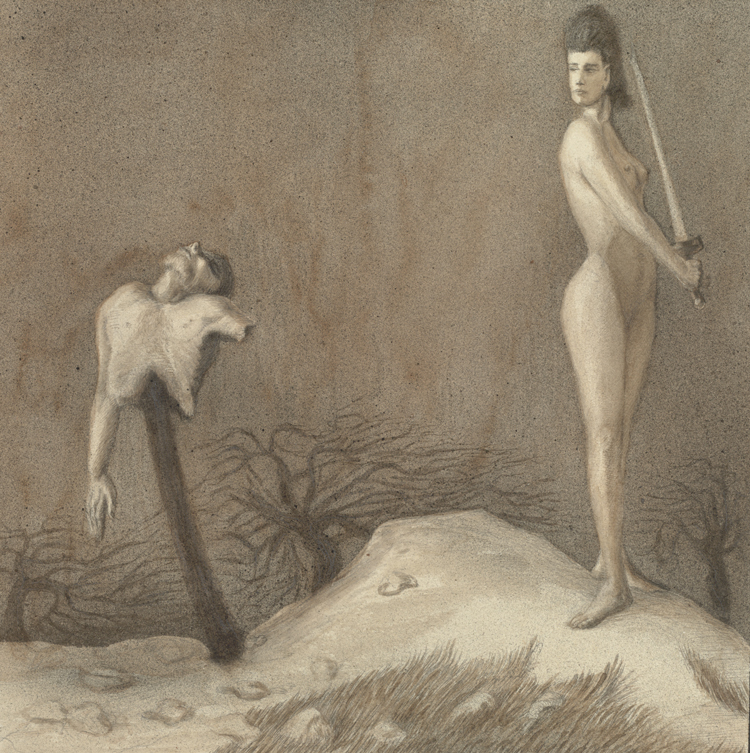
Alfred Kubin. Feast after the Slaughter, c1900. Ink on paper, 22.8 x 22.9 cm. The Albertina Museum, Vienna © Eberhard Spangenberg, München / Bildrecht, Vienna 2024.
Kubin also found inspiration in the work of the philosophers Schopenhauer and Nietzsche, claiming to have read all their works in a few days. After this intensive reading period, he concluded that Schopenhauer’s pessimistic worldview was “the only correct one”, though he found much to admire in Nietzsche.3 He lamented “the meaningless contradiction of the world, which becomes grandly and profoundly significant only through true mystico-artistic contemplation. The transitoriness of earthly things is a sublime horror, to reflect on this and to see the good in it demands true heroism.”
At this time, he became involved in the hotbed of artistic experimentation in Germany; as an expressionist, he was linked with Oskar Kokoschka, Chaïm Soutine, Max Beckmann and George Grosz, though his particular sharpness of line was unique. He focused on etching, pen and ink drawing, and lithograph techniques, becoming involved with the Blaue Reiter group in Berlin, and when they combined with the Brücke group in an exhibition, Kubin was shown alongside André Derain, Maurice de Vlaminck, Paul Klee, Pablo Picasso and Georges Braque. He was friends with Klee and Wassily Kandinsky, but he did not let any joy of friendship or artistic success undermine the deep melancholy of his work. In fact, during this time, he produced some of his most relentlessly bleak drawings.
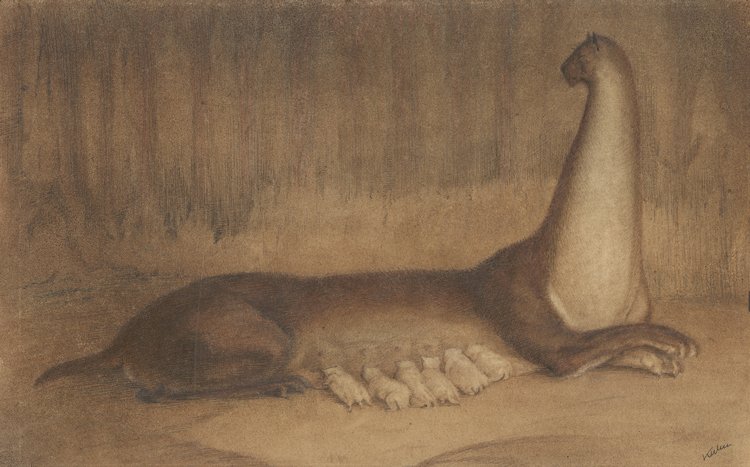
Alfred Kubin. The Brood, 1903-06. Ink on paper, 22.8 x 36.2 cm. The Albertina Museum, Vienna © Eberhard Spangenberg, München / Bildrecht, Vienna 2024.
In one etching, titled simply Torture (c1900), for instance, an emaciated naked man, his hands tied behind his back, is suspended horizontally, his feet tied to the top of a pole while his head is held aloft by a stake through his mouth. A fire burns beneath the figure, scorching his belly black. It is unclear who or what has done this to the man, and he gazes out hauntingly at the viewer. In Annihilation (1902), there are two figures, one standing ominously with two swords hanging from his belt and one levitating cross-legged; it is unclear why or how these figures are threatening, and yet as they seem to lock eyes with whoever views the drawing, they infuse a sense of foreboding. “I don’t create out of pleasure,” Kubin stated at this time, and in these works he confronts us directly with figures that express a sense of the abyss, inspired by Schopenhauer and Nietzsche. With his impaled, bound and hanged figures, Kubin presents to his viewers the pain humans are capable of inflicting on one another, and often do. Inspired by Francisco Goya, Pieter Bruegel and Hieronymus Bosch, Kubin revealed the sadism that he saw infiltrating everyday life in peacetime as well as wartime, perpetually bleeding into one’s consciousness. In his scenes of torture and sexual deviance, there are clear influences from his peer Franz Kafka and the French libertine and author the Marquis de Sade.
Around the time these striking works were created, Kubin had his first successes; and in 1903 became widely recognised when the Weber Portfolio, a collection of facsimile prints of his drawings, was published. That same year, he fell in love with Emmy Bayer, with whom he spent a few euphoric months. The couple quickly became engaged, and briefly the tone of his work became less disturbing, which Kubin claims in his autobiography was due to having a regular sex life for the first time. Sadly, this happiness was to be shortlived; Bayer died suddenly in December 1903. Kubin said: “When I stood in front of her lifeless body, I suddenly realised my happiness was gone, once and for all. In my boundless despair, I wanted to scream, but I could utter no sound to ease my pain. My life seemed terribly desolate and empty; I lost all desire to live and dissipated my savings, for everything seemed pointless now.”4
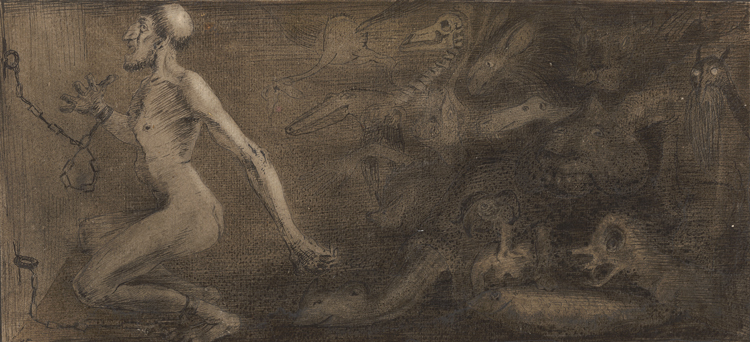
Alfred Kubin. The Prisoner, before 1900. Ink on paper, 12.6 x 27.3 cm. The Albertina Museum, Vienna © Eberhard Spangenberg, München / Bildrecht, Vienna 2024.
A few months later, however, Kubin met Hedwig Grundler, a wealthy young widow, whom he married in 1904, just nine months after the death of Bayer. The couple purchased Zwickledt Castle, which became their lifelong residence. Kubin biographer Phillip Rhein described the marriage as “perhaps based more on friendship and understanding than on passionate love”.5 It was not a marriage without its turbulence, however, as Hedwig was often unwell and became addicted to morphine, spending frequent spells in sanatoriums. The substantial dowry they received was depleted by her severe morphine habit, and new fears of poverty and death added to Kubin’s anxiety. The intensely bleak drawings continued apace: in that year, he created Human Destiny (1903), a scene of a hooded nude figure raking in a mass of tiny desperate figures, is if human lives were just crops planted and harvested arbitrarily, with little attention paid to their souls. He also drew Epidemic (1903), in which a strange creature made of bones seems to pour contagion into a house during winter. In 1905, still a newlywed, he produced Angst, in which a mob of desperate bodies are haunted by a looming head.

Alfred Kubin. The Large Head, 1899. Ink on paper, 19.2 x 15.6 cm. The Albertina Museum, Vienna © Eberhard Spangenberg, München / Bildrecht, Vienna 2024.
Kubin’s father’s death in 1907 triggered another personal crisis, and suffering from an inability to draw this time, the artist wrote his only book, the daring and fantastical novel Die Andere Seite (The Other Side), which was a brilliant success and won him the admiration of Franz Kafka among other literary peers. In this text, he seemed to break through his philosophical and spiritual problems, finding some acceptance of the human condition, and the death he had always feared, and which had tormented him so badly. As his narrator finally states:
“To my horror I found that my ‘self’ was composed of countless ‘selves’, each one lurking behind the other, each one seeming bigger and more taciturn than the one in front. The last ones disappeared in the shadows, beyond my comprehension. Each of these selves had ideas of its own. From the point of view of organic life, for example, the concept of death as the end was correct, but on a higher plane of understanding the individual did not exist, so that there was nothing to come to an end … At the end of this development man as an individual disappears, is no longer needed. This path leads to the stars.”
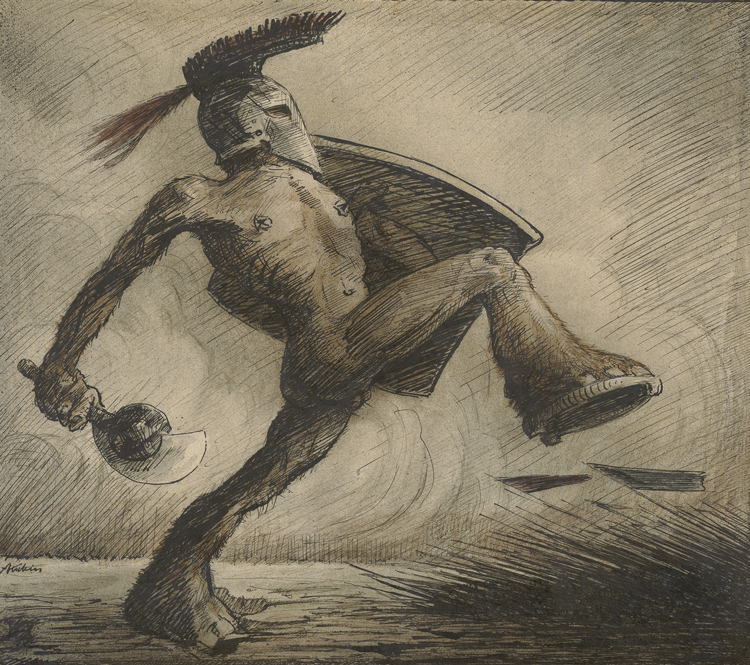
Alfred Kubin. War, c1918. Ink on paper, 30.2 x 34.5 cm. The Albertina Museum, Vienna © Eberhard Spangenberg, München / Bildrecht, Vienna 2024.
In his final decades, Kubin lived an isolated life with Hedwig on their estate in northern Austria, through the first and then second world wars, with Hedwig dying in 1948. When the Nazis rose to power, Kubin’s work was unsurprisingly declared “degenerate art”. Some works were sold under duress by Max and Hertha Morgenstern of Vienna to Hamburg collector Kurt Otte, though they were later returned to the couple’s heirs with the assistance of the Commission for Looted Art in Europe, with other stolen works later retrieved by the German Lost Art Foundation. Kubin kept working discreetly through the wars, but lost touch with his avant garde friends and worked mostly in isolation. He also turned away from his own scenes of angst and horror and worked more intently as an illustrator of the works of writers he admired – Edgar Allan Poe, Dostoevsky, Balzac, Thomas Mann, Kafka and Gustave Flaubert.
The great Austrian draughtsman died in 1959, buried with his wife, Hedwig, after a life of exorcising, in his unique style, the demons that plagued him persistently, but which terrorise all people to some degree. Kubin found in his deep alienation and grief a common hell that, for all the melancholy, he also satirised and played with, transforming monstrosity into something elegant. Perhaps in this practice, in the hundreds of remarkable, uncanny drawings he created, he found a little respite, and even joy. In all the mystical animals and perverted tyrants he brings to our consciousness in these artworks, I cannot help but sense some sly joy, a soft hum of laughter, at the sheer absurdity of this dazzlingly cruel world, which Kubin so loved to hate.
References
1. Alfred Kubin: Confessions of a Tortured Soul, edited by Hans-Peter Wipplinger, published by Walther Und Franz König, 2022, page 26.
2. Quoted in exhibition wall text.
3. The Verbal and Visual Art of Alfred Kubin by Phillip H Rhein, published by Ariadne Press, 1989, page 10.
4. Alfred Kubin, by Wieland Schmied and Alfred Marks, translated by Jean Steinberg, published by Frederick A Praeger, 1967, page 11.
5. The Verbal and Visual Art of Alfred Kubin, op cit.